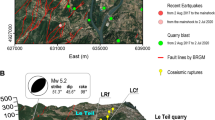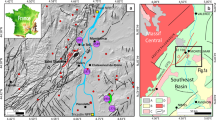Abstract
Throughout most of the Himalaya, slip of the Indian Plate is restrained by friction on the interface between the plate and the overlying wedge of Himalayan rocks. Every few hundred years, this interface—or décollement—ruptures in one or more Mw ≥8 earthquakes. In contrast, in the westernmost Himalaya, the Indian Plate slips aseismically beneath wide plateaux fronting the Kohistan Mountains. The plateaux are underlain by viscous décollements that are unable to sustain large earthquakes1. Potwar, the widest of these plateaux is underlain by viscous salt2,3, which currently permits it to slide at rates of about 3 mm yr−1 (refs 4, 5), much slower than its 2 Myr average6,7. This deceleration has been attributed to recently increased friction through the loss of salt from its décollement. Here we use interferometric synthetic aperture radar and seismic data to assess movement of the Kohat Plateau—the narrowest and thickest plateau8,9. We find that in 1992 an 80 km2 patch of the décollement ruptured in a rare Mw 6.0 earthquake, suggesting that parts of the décollement are locally grounded. We conclude that this hybrid seismic and aseismic behaviour represents an evolution of the mode of slip of the plateaux from steady creep towards increasingly widespread seismic rupture.
This is a preview of subscription content, access via your institution
Access options
Subscribe to this journal
Receive 12 print issues and online access
$259.00 per year
only $21.58 per issue
Buy this article
- Purchase on Springer Link
- Instant access to full article PDF
Prices may be subject to local taxes which are calculated during checkout



Similar content being viewed by others
References
Martin, S. & Szeliga, W. A catalog of felt intensity data for 589 earthquakes in India: 1636–2009. Bull. Seismol. Soc. Am. 100, 536–569 (2010).
Yeats, R. S., Khan, S. H. & Akthar, M. Late quaternary deformation of the Salt Range of Pakistan. Geol. Soc. Am. Bull. 95, 958–966 (1984).
Butler, R. W. H., Coward, M. P., Harwood, G. M. & Knipe, R. in Dynamical Geology of Salt and Related Structures (eds O’Brien, J. J. & Lerche, I.) 399–418 (Academic, 1987).
McDougall, J. W. & Khan, S. H. Strike-slip faulting in a foreland fold–thrust belt: The Kalabagh fault and western Salt Range, Pakistan. Tectonics 9, 1061–1075 (1990).
Baker, D. M. et al. Development of the Himalayan frontal thrust zone: Salt Range, Pakistan. Geology 16, 3–7 (1988).
Khan, M. A. et al. Preliminary geodetic constraints on plate boundary deformation on the western edge of the Indian plate from TriGGnet (Tri-University GPS Geodesy Network). J. Himal. Earth Sci. 41, 71–87 (2008).
Chen, L. & Khan, S. D. InSAR observation of the strike-slip faults in the northwest Himalayan frontal thrust system. Geosphere 6, 731–736 (2010).
Pivnik, D. A. & Sercombe, W. J. in Compression and Transpression Related Deformation in the Kohat Plateau, NW Pakistan Vol. 44 (eds Searle, M. P. & Treloar, P.) 559–580 (Himalayan tectonics: Geol. Soc. London Spec. Publ., 1993).
Sercombe, W. J. et al. Wrench Faulting in the northern Pakistan foreland. AAPG Bull. 82, 2003–2030 (1998).
Oldham, R. D. Know your faults. J. Geol. Soc. Lond. 77, 77–02 (1921).
Davis, D. M. & Engelder, T. in Dynamical Geology of Salt and Related Structures (eds Lerche, I. & O’Brien, J. J.) 301–337 (Academic, 1987).
De Bremaecker, J. Cl. Thrust sheet motion and earthquake mechanisms. Earth Planet. Sci. Lett. 83, 159–166 (1987).
Brune, J. Particle motions in a physical model of shallow angle thrust faulting. Proc. Indian Acad. Sci. 105, 197–206 (1996).
Andrews, D. J. & Ben-Zion, Y. Wrinkle-like slip pulse on a fault between different materials. J. Geophys. Res. 102, 553–571 (1997).
Cotton, J. T. & Koyi, H. A. Modelling of thrust fronts above ductile and frictional detachments: Application to structures in the Salt Range and Potwar Plateau, Pakistan. Geol. Soc. Am. Bull. 112, 351–363 (2000).
Ford, M. Depositional wedge tops: Interaction between low basal friction external orogenic wedges and flexural foreland basins. Basin Res. 16, 361–375 (2004).
Jaumé, S. C. & Lillie, R. J. Mechanics of the Salt Range–Potwar Plateau, Pakistan: A fold-and-thrust belt underlain by evaporites. Tectonics 7, 57–71 (1988).
Seeber, L. & Armbruster, J. G. in Geodynamics of Pakistan: Geological Survey of Pakistan (eds Farah, A. & DeJong, K. A.) 131–142 (1979).
Quittmeyer, R. C. & Jacob, K. H. Historical and modern seismicity of Pakistan, Afghanistan, Northwestern India, and Southeastern Iran. Bull. Seismol. Soc. Am. 69, 773–823 (1979).
Abbasi, I. A. & McElroy, R. Thrust kinematics of the Kohat Plateau, Trans-Indus Salt Range, Pakistan. J. Struct. Geol 13, 319–327 (1991).
McDougall, J. W. & Hussain, A. Fold and thrust propagation in the western Himalaya based on a balanced cross-section of the Surghar range and Kohat Plateau, Pakistan. AAPG Bull. 75, 463–478 (1991).
Engdahl, E. R., van der Hilst, R. & Buland, R. Global teleseismic earthquake relocation with improved travel times and procedures for depth determination. Bull. Seismol. Soc. Am. 88, 722–743 (1998).
Engdahl, E. R. & Villaseñor, A. in International Handbook of Earthquake and Engineering Seismology, Part A (eds Lee, W. H. K., Kanamori, H., Jennings, P. C. & Kisslinger, C.) Chapter 41, 665–690 (Academic, 2002).
Mona, L., Khwaja, A. A & Qureshi, S. N. Structural interpretation on the basis of focal mechanism studies in the area of Kohat Plateau, Bannu Basin and Western Extension of Salt Range. Pak. J. Hydrocarbon Res. 15, 43–51 (2005).
Mohadjer, S. et al. Partitioning of India–Eurasia convergence in the Pamir Hindu Kush from GPS measurements. Geophys. Res. Lett. 37, L04305 (2010).
Sammis, C. G. & Rice, J. R. Repeating earthquakes as low-stress-drop events at a border between locked and creeping fault patches. Bull. Seismol. Soc. Am. 91, 532–537 (2001).
Templeton, D. C., Nadeau, R. M. & Burgmann, R. Behavior of repeating earthquake sequences in Central California and the implications for subsurface fault creep. Bull. Seismol. Soc. Am. 98, 52–65 (2008).
Johnson Lane, R. & Nadeau, R. M. Asperity model of an earthquake: Static problem. Bull. Seismol. Soc. Am. 92, 672–686 (2002).
Hetland, E. A. & Simons, M. Post-seismic and interseismic fault creep II: Transient creep and interseismic stress shadows on megathrusts. Geophys. J. Int. 181, 99–112 (2010).
Acknowledgements
The authors thank S. P. Arun, M. Furuya, P. Molnar, B. Engdhal, G. Ekström, M. Lisa and M. Simon for discussions. Synthetic aperture radar data were provided by the European Space Agency through Category-1 project no 3163. This work was initiated while S.P.S. was a Cooperative Institute for Research in Environmental Sciences Visiting Fellow at the University of Colorado, Boulder, and was completed at the National Geophysical Research Institute, Hyderabad. R.B. was supported by National Science Foundation grant EAR3473959.
Author information
Authors and Affiliations
Contributions
S.P.S. undertook the Insar analysis, Z.Y. undertook the seismic analysis, and all three authors drafted the article.
Corresponding author
Ethics declarations
Competing interests
The authors declare no competing financial interests.
Supplementary information
Supplementary Information
Supplementary Information (PDF 2440 kb)
Rights and permissions
About this article
Cite this article
Satyabala, S., Yang, Z. & Bilham, R. Stick–slip advance of the Kohat Plateau in Pakistan. Nature Geosci 5, 147–150 (2012). https://doi.org/10.1038/ngeo1373
Received:
Accepted:
Published:
Issue Date:
DOI: https://doi.org/10.1038/ngeo1373
This article is cited by
-
Source parameters of the Fatehjang, Pakistan earthquake \(({M}_{w} 4.1)\) of 28 August 2020
Arabian Journal of Geosciences (2022)
-
Distance attenuation and local magnitude scale based on constant geometrical spreading in Northern Punjab, Pakistan
Acta Geophysica (2021)
-
RETRACTED ARTICLE: Urban land ecological evaluation and English translation model optimization based on machine learning
Arabian Journal of Geosciences (2021)
-
Delineation of sinkhole in evaporite deposits using electrical resistivity survey: a case study of southern Kohat Plateau, Pakistan
Arabian Journal of Geosciences (2021)
-
Development of local magnitude scale for the Northern Punjab, Pakistan
Journal of Seismology (2019)



